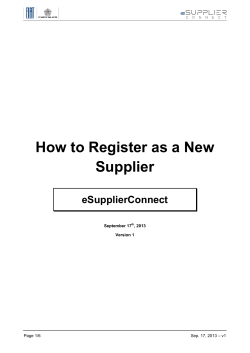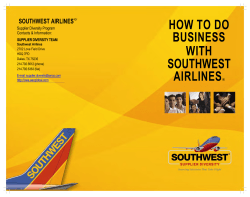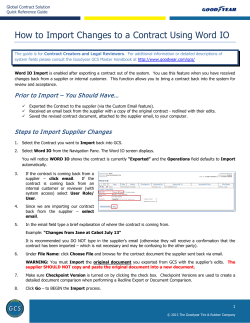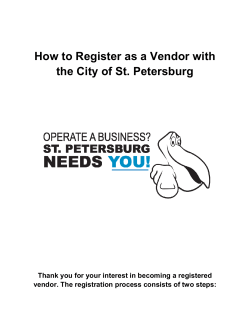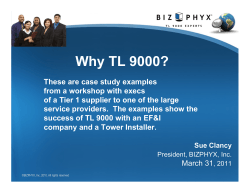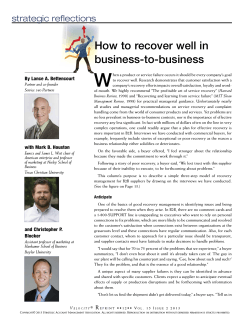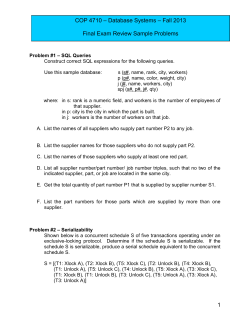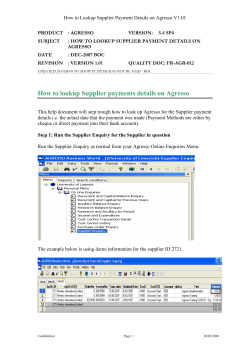
Supplier Manual
Supplier Manual Revision 12 – September 2014 Supplier Portal: http://www.fst.com/company/supplier-portal Table of Contents OVERVIEW ......................................................................................................................................... 3 1.1 FREUDENBERG-NOK SEALING TECHNOLOGIES MISSION STATEMENT .............. 3 1.2 STATEMENT OF PURPOSE AND INTENT ......................................................................... 3 1.3 APPLICATION ........................................................................................................................... 3 1.4 VALIDATION OF SUPPLIER QUALITY SYSTEMS............................................................ 3 2. SUPPLY BASE MANAGEMENT ..................................................................................................... 4 2.1 ORGANIZATIONAL RESPONSIBILITY ................................................................................ 4 2.2 NEW SUPPLIERS .................................................................................................................... 4 3. QUALITY PLANNING ........................................................................................................................ 4 3.1 ADVANCED PRODUCT QUALITY PLANNING (APQP).................................................... 4 3.2 PROTOTYPE PARTS .............................................................................................................. 5 3.3 PRODUCTION PART APPROVAL PROCESSES .............................................................. 5 3.4 EARLY PRODUCTION CONTAINMENT .............................................................................. 6 4. ONGOING QUALITY REQUIREMENTS ........................................................................................ 6 4.1 PROOF OF CONFORMANCE ............................................................................................... 6 4.2 STATISTICAL PROCESS CONTROL (SPC) AND PROCESS CAPABILITY ................ 7 4.3 GAGES AND MEASURING SYSTEMS ................................................................................ 7 4.4 SUPPLIER CORRECTIVE ACTION REQUESTS ............................................................... 7 4.5 NONCONFORMING MATERIAL ........................................................................................... 8 4.6 STRUCTURED PROBLEM SOLVING .................................................................................. 9 4.7 CHARGEBACK ......................................................................................................................... 9 4.8 SUPPLIER CHANGE MANAGEMENT ................................................................................. 9 4.9 LABELING................................................................................................................................ 10 4.10 EVIDENCE OF ON-GOING QUALITY REGISTRATION ................................................. 10 5. SUPPLIER PERFORMANCE FEEDBACK .................................................................................. 10 5.1 PURPOSE................................................................................................................................ 10 5.2 FREQUENCY OF ASSESSMENT ....................................................................................... 10 5.3 SUPPLIER PERFORMANCE REPORTING SYSTEM ..................................................... 11 5.4 OVERALL PERFORMANCE RATING LEVELS ................................................................ 12 6. SUPPLY CHAIN EXPECTATIONS ............................................................................................... 13 6.1 IMPORT AND EXPORT COMPLIANCE ............................................................................. 13 6.2 TRANSPORTATION .............................................................................................................. 14 6.3 ELECTRONIC COMMERCE................................................................................................. 16 6.4 GUIDELINES FOR INTERACTION WITH DIRECT MATERIAL SUPPLIERS ............. 16 6.5 SUPPLY CHAIN PORTAL GUIDELINES AND EXPECTATIONS .................................. 17 6.6 CORPORATE SOCIAL RESPONSIBILITY POLICY ........................................................ 18 7. APPENDICES ................................................................................................................................... 19 7.1 Appendix A – Acronyms and their meanings ..................................................................... 19 7.2 Appendix B – Supplier Change Request Form .................................................................. 21 7.3 Appendix C – Example of 8D Corrective Action Report ................................................... 22 7.4 Appendix D – Technical Score Rubric for Component Suppliers.................................... 24 7.5 Appendix E – Technical Score Rubric for Bulk Raw Material Suppliers ........................ 25 7.6 Appendix F – FNST Supplier Manual Contact Information .............................................. 26 1. Rev. 12 September 2014 Freudenberg-NOK Supplier Manual WI-06-PURC-000 2 of 26 1. OVERVIEW 1.1 FREUDENBERG-NOK SEALING TECHNOLOGIES MISSION STATEMENT 1.2 STATEMENT OF PURPOSE AND INTENT A total commitment to customer satisfaction and continuous quality improvement must be shared by Freudenberg-NOK Sealing Technologies (FNST) and all of its suppliers. As a part of the supply chain, together we must maintain effective quality management systems if we are to remain competitive in the market place. FNST quality is complemented by the combined efforts of its suppliers. It is the intent of FNST to purchase from suppliers who consistently meet FNST expectations for quality, delivery, value and service as well as share in our attitude toward prevention versus detection. This manual is a tool to inform suppliers of FNST expectations and requirements and to communicate how suppliers will be measured against these requirements. The requirements set forth in this manual shall apply to all suppliers of direct materials including, but not limited to those providing production materials, those providing production components and those providing services (e.g. heat treating, painting, plating, etc.) that in any way impact the form, fit or function of direct materials being supplied to FNST. 1.3 APPLICATION The requirements stated in this manual are in addition to (and do not replace or supersede) any of the requirements outlined in FNST issued purchase orders, engineering drawings, specification requirements, FNST Terms and Conditions of purchasing, or other FNST supplier requirements. They do not relieve the supplier from the responsibility of ensuring that all materials supplied to FNST meet all of the requirements specified by FNST. In addition to this manual, some FNST locations may issue supplements detailing additional requirements for their location. Always check with the Site Quality Manager at the specific FNST site being supplied for additional information. 1.4 VALIDATION OF SUPPLIER QUALITY SYSTEMS As a supplier of sealing products to a broad range of industries, FNST has sites that are ISO 9001 certified, ISO/TS 16949 certified, AS9100 certified and/or ISO 13485 certified. FNST prefers suppliers that have quality systems that are third-party certified to an industry appropriate quality system standard. Unless otherwise allowed for by FNST, all suppliers to FNST shall be certified to ISO 9001, ISO/TS 16949, AS9100 and/or ISO 13485 by an accredited third-party certification body. The scope of products purchased and the end-use applications may be limited based on the type(s) of certifications held by the supplier. Rev. 12 September 2014 Freudenberg-NOK Supplier Manual WI-06-PURC-000 3 of 26 This FNST Supplier Manual can be found at http://www.fst.com/company/supplier-portal. Other quality systems requirements and associated supplements can be obtained from the Automotive Industry Action Group (AIAG) via their website at http://www.aiag.org. To ensure that FNST expectations are met, on-site surveys, self-surveys and supplier profile information may be requested for potential or current suppliers. Disciplines subject to evaluation via on-site surveys may include, but are not limited to quality systems, management structure, cost, delivery, technology, and the supplier’s expertise in Lean Manufacturing or Six Sigma. 2. SUPPLY BASE MANAGEMENT 2.1 ORGANIZATIONAL RESPONSIBILITY All raw material and component purchases are managed through the FNST Corporate Supply Chain Management and Logistics (SCM&L) organization. Under this structure, each purchased raw material or component is assigned a commodity type. This ensures consistent sourcing considerations across all suppliers within a commodity and between all sites within FNST. Each commodity is assigned a manager. Commodity Manager responsibilities include; establishing and maintaining lists of approved suppliers, submitting requests for quotes, awarding new business, and establishing commercial terms and conditions for suppliers within their commodity. 2.2 NEW SUPPLIERS A supplier is considered a new supplier if it has never done business with FNST or if it has not supplied any product to FNST for at least three years. All new suppliers must be approved prior to the awarding of new business. The complete list of approved suppliers resides in the FNST Supplier Management database within the FNST quality management system. The approval process includes providing evidence of an industry appropriate third-party quality system registration by an internationally recognized registrar, passing the FNST Cross Functional Evaluation (CFE) and being approved by the Commodity Manager and required FNST management team members. 3. QUALITY PLANNING 3.1 ADVANCED PRODUCT QUALITY PLANNING (APQP) Product quality planning is a structured method of defining and establishing the steps necessary to assure that a product satisfies the customer. Suppliers are required to become involved early in the product development process. Suppliers are responsible to understand the use of their material and its impact on the quality of the finished product. All aspects of material performance and expectation should be clearly understood by the supplier. Supplier may be required to participate in FNST plant level APQP programs. This may include but not limited to technical review, design reviews, logistics planning, pre-PPAP planning and other activities as defined by FNST manufacturing, engineering or SCM&L. Suppliers shall implement project planning and are encouraged to follow the five APQP phases and incorporate the seven elements of APQP to ensure timely delivery of material or components and achievement of program cost and timing goals. Suppliers shall inform receiving FNST site, corporate commodity manager and corporate supplier development of APQP timeline, goals and progress. For quality planning, FNST suppliers should reference the most recent editions of the following manuals published by the Automotive Industry Action Group (AIAG): Production Part Approval Process - PPAP, Potential Failure Mode & Effects Analysis – FMEA, Advanced Product Quality Planning & Control Plan – APQP, Measurement System Analysis – MSA and Statistical Process Rev. 12 September 2014 Freudenberg-NOK Supplier Manual WI-06-PURC-000 4 of 26 Control – SPC. Non-automotive suppliers can reference these manuals or equivalent manuals from other appropriate industry groups. 3.2 PROTOTYPE PARTS Prototype parts or sample materials may be required for functional testing and plant trial run purposes. Facility personnel will coordinate requirements with suppliers. 3.3 PRODUCTION PART APPROVAL PROCESSES The specific process(es) for approving materials or components for production will depend on the industry or industries being served and the preferences of the receiving FNST site(s). The supplier shall contact the Quality Department at the receiving FNST site(s) to obtain a list of part approval process requirements. FNST adheres to the guidelines in the AIAG publication Production Part Approval Process – PPAP for approving all purchased materials and components for automotive applications. Suppliers shall obtain a list of FNST specific PPAP requirements from each receiving FNST site. PPAP submissions are to be submitted to the Quality Department at the receiving FNST site, but may be approved by the Quality Department at the using or molding site if applicable. End customer specific requirements are in addition to any FNST or AIAG manual requirements. Suppliers are responsible for keeping up-to-date with any and all end customer specific requirements. 3.3.1 PPAP Specific Submission Requirements The default PPAP submission level will be to AIAG PPAP manual Level-3 requirements. The receiving FNST site has the option to change the submission level requirements. FNST requires that all PPAP documentation shall be completed and available for review, regardless of the submission level requested. In addition to the level-3 submission, any applicable MSDS shall be included with PPAP submissions as well as all documentation for any customer specific requirements. Once FNST has approved the supplier PPAP submission, the part is considered production ready, and the ongoing supplier performance measurement and maintenance is in accordance with “Section 5 - Supplier Performance” of this document. 3.3.1.1 Heat Treat Requirements All suppliers of heat treated material to FNST shall provide documentation of an AIAG CQI-9 audit performed by a second party for each heat treat service provider used by the supplier. If the supplier performs heat treating, they shall either supply an audit performed by a Tier 1, OEM customer or submit to an audit by FNST. Any identified “not satisfactory” or “needs immediate action” items shall have a documented action plan. This documentation shall be updated and provided to FNST on an annual basis. 3.3.1.2 “Not Satisfactory” or “Needs Immediate Action” Items Suppliers shall not submit a PPAP with non-conforming characteristics without previous written approval from the receiving FNST site(s). Any “not satisfactory” or “needs immediate action” items identified in the PPAP package affecting product fit, form, functional performance or quality shall require an action plan for improvement and may be grounds for PPAP denial. In addition, any previous and current product lots must be tested for proof of acceptability use. If non-conforming conditions exist, the supplier shall immediately notify the receiving FNST site(s), Corporate Supplier Development, and Commodity Manager. All suspect products are to be placed into containment until disposition approval is granted by the receiving FNST site(s) and/or Corporate Supplier Development. Rev. 12 September 2014 Freudenberg-NOK Supplier Manual WI-06-PURC-000 5 of 26 3.3.1.3 Potential Failure Modes & Effects Analysis and Control Plan The Process FMEA shall document the manufacturing process, any significant characteristics and the actions implemented to reduce the Risk Priority Numbers (RPN) associated with any of the potential failure modes. Use of the AIAG FMEA manual as a guideline is recommended. Control Plans shall be developed identifying significant characteristics and noting the control mechanisms and reaction plans in the event of the failure of the mechanism. Use of the AIAG APQP and Control Plan Manual as a guideline is recommended. 3.4 EARLY PRODUCTION CONTAINMENT It is highly recommended that suppliers implement an early production containment program to ensure a smooth launch with FNST. At the request of the receiving FNST site or of Corporate SCM&L, the supplier shall implement an early production containment program. In the case of this request, a formal Pre-Launch Control Plan detailing the additional controls, increased inspection audits, and extra testing to be used to identify non-conformances during the production process ramp-up shall be developed. Depending on the dominant factor(s) of the production process (set-up, machinery, fixture, tooling, operator, material/components, preventative maintenance, climate), additional controls shall include: Off-line, separate and independent checks from the normal production process whenever possible. Mandatory 100% inspection, as determined by the supplier and receiving FNST site, for all pre-production and pilot parts shipped. Increased frequency/sample size of receiving, process and or shipping inspections after preproduction and pilot. Mandated sub-supplier containment and or sub-supplier support/audits. Addition of inspection/control items. Increased verification of label accuracy. Enhanced process controls such as error proofing. Error proofing validation through introduction of known defects. Early Production Containment data shall be retained per quality system requirements and available upon request by FNST Supply Chain Management and/or the receiving FNST site(s). Data should include date and quantity of product manufactured, inspection findings and countermeasures taken. Early Production Containment shall remain in place until such time as the risk of shipment of nonconforming product is minimized or exit is approved by the receiving FNST site. 4. ONGOING QUALITY REQUIREMENTS 4.1 PROOF OF CONFORMANCE Suppliers may be required to submit proof of conformance of materials in the form of Certificates of Compliance, Certificates of Analysis, or Material Certifications with each shipment of material. These submissions should state actual test results or measurements for each Significant Characteristic (SC) listed on the purchasing specification and/or print for components and for each physical property tested for bulk raw materials. The submissions shall identify the purchase order, lot or batch and specific quantity of material covered by the certification. Rev. 12 September 2014 Freudenberg-NOK Supplier Manual WI-06-PURC-000 6 of 26 The proof of conformance submissions shall be provided to the receiving FNST site before or at the time of material arrival at FNST. For certain bulk raw materials, FNST may request for the Certificates of Analysis to be submitted to a dedicated repository for physical property trend monitoring. Corporate SCM&L will contact the supplier if this is required. When it is not required to send material certifications to FNST, proof of conformance must be retained at the supplier location and made available upon request by FNST. In addition, supplier shall maintain lot traceability and proof of material conformance records for the current year plus three full years, or longer if requested by the receiving FNST site. This information shall be made available to FNST upon request. 4.2 STATISTICAL PROCESS CONTROL (SPC) AND PROCESS CAPABILITY Statistical Process Control information may be required to be submitted to FNST on a regular basis as supporting verification of material quality. Each FNST receiving site may have SPC requirements in addition to the ones outlined in this supplier manual. Each FNST receiving site may have different requirements for SPC at PPAP (short-term) and during production (longterm). In addition, minimum requirements for process capability studies may differ between FNST sites. Please contact your receiving FNST site, corporate commodity manager or corporate supplier development for specific details. At a minimum, Significant Characteristics, Critical Characteristics and those characteristics with safety implications shall be identified on the control plan and shall be recorded and monitored with out-of-control conditions noted. Suppliers shall ensure that out-of-control material is verified as compliant to Specifications before being released for shipment to FNST. Special causes of variation should be investigated, identified and eliminated. Significant Characteristics, Critical Characteristics and those characteristics with safety implications will be identified via the engineering drawing, print or material specification. Where applicable, Cpk shall be calculated and monitored to ensure long-term process capability of material supplied to FNST. Suppliers shall target a minimum Cpk of 1.67 unless otherwise specified by the receiving FNST site. Other measures of long term capability and stability of material will be considered on a case-by-case basis depending on the type of process and risk level of the material. Use of the AIAG manual Statistical Process Control – SPC as a guideline is suggested. 4.3 GAGES AND MEASURING SYSTEMS Gages and measuring instruments used for verification of quality must be maintained and calibrated in accordance with ISO/TS 16949 requirements. Use of the AIAG MSA Manual as a guideline is suggested. All gages used to measure characteristics denoted on the process control plan must have a gage R&R <10% or a deviation signed by the receiving FNST site. Suppliers are required to inform FNST of material shipped and found to be manufactured with damaged or out-of-calibration equipment. 4.4 SUPPLIER CORRECTIVE ACTION REQUESTS FNST has implemented a uniform Supplier Management process utilizing our company wide quality software system. A Supplier Corrective Action Request (SCAR) is documented by the plant when a supplier issue occurs. The plant personnel will enter a supplier issue into the FNST quality system and designate the SCAR as a Product Related problem, a Delivery problem, a Documentation issue, a Customer Service error or a Commercial Problem. A Delivery SCAR may impact the supplier’s delivery rating. A Quality SCAR will impact the supplier’s quality rating. (See Section 5.3). Issues requiring a response from the supplier will be communicated to the supplier in a timely manner. Suppliers are expected to respond to the SCAR within 24 hours for acknowledgement, 72 hours for containment and 30 days for closure. Rev. 12 September 2014 Freudenberg-NOK Supplier Manual WI-06-PURC-000 7 of 26 Suppliers are expected to use structured problem solving techniques such as 8D or 5-why, to generate a timely response with corrective actions that permanently eliminate the root cause of the defect (See Structured Problem Solving section). Responses are expected in common electronic format (e.g. MSWord, MS Excel) and should be submitted via e-mail. 4.5 NONCONFORMING MATERIAL 4.5.1 Customer Notification of Nonconforming Material Suppliers are required to immediately notify FNST of nonconforming or suspect material that may be in transit or already delivered. Such action is required by FNST and will reduce the severity of the quality incident. All communications should be directed to the receiving FNST site, Corporate Commodity Manager and Corporate Supplier Development. 4.5.2 Containment of Nonconforming Material at the Supplier Facility Suppliers are expected to react immediately and authoritatively to contain any suspect or nonconforming material to ensure that the impact on FNST production is minimal. Nonconforming material shall be immediately contained by the supplier. Suppliers shall implement a 100% off-line inspection of suspect lots. Suppliers shall inform FNST of any material that could be considered suspect at the receiving FNST site. Records of nonconforming material and customer notification shall be retained per quality system requirements and available upon request by FNST Supply Chain Management and/or the receiving FNST site. 4.5.3 Nonconforming Material at FNST FNST has the option to request assistance from the supplier for on-site inspection of nonconforming material at either, or both, FNST and the end user’s facility. If nonconforming material is found in at a receiving FNST site, 100% 3rd party containment may be implemented at the supplier, FNST or end customer site until the root cause is determined and a permanent corrective action is demonstrated. The receiving FNST site or end customer shall determine the length of time for 3rd party containment. A report detailing the daily fallout from 3rd party containment shall be provided to FNST during this period. All costs incurred from on-site inspection and/or 3rd party containment will be at the supplier’s expense. Nonconforming material will count against the supplier’s quality performance score and PPM rating. Quality performance will be communicated to the supplier through the Supplier Performance Feedback report. 4.5.4 Deviation Request Suppliers are obligated to quarantine any nonconforming, suspect, or unapproved material (see 4.4.2). Under certain circumstances, suppliers may be granted a deviation in order to continue shipments. A deviation request shall be directed to the receiving FNST site and copied to the corporate Commodity Manager and Corporate Supplier Development. FNST will evaluate the risks of using the nonconforming material and consider the impact on the production schedule and customer delivery before approval of the request (See Section 4.4.4). Material may not be shipped until the deviation has been approved in writing by the receiving FNST site. Deviations are to be for a specific quantity of material or for a specific time period which will be determined by the receiving FNST site. If a deviation is granted and these parts are shipped to FNST, the parts shall be labeled at a minimum on all four sides of the shipping container. The receiving FNST site may request additional labeling of these parts at the expense of the supplier. Rev. 12 September 2014 Freudenberg-NOK Supplier Manual WI-06-PURC-000 8 of 26 4.5.5 Disposition of Nonconforming Material Each FNST manufacturing site shall determine the disposition of supplier non-conforming material. A multi-discipline team convenes as necessary to evaluate the risks of using the nonconforming material and consider the impact on the production schedule and customer delivery. All costs associated with returning or disposing of supplier nonconforming material will be at the supplier’s expense. 4.5.6 Visually Nonconforming Material Unless other arrangements are made in advance of shipment, FNST expects all materials to be supplied with consistent appearance (consistent color, texture, shape, packaging, etc.). Visually nonconforming materials will be rejected and a product SCAR will be issued unless FNST is notified in advance that the nonconforming material is being shipped. The advance notification shall include (1) a description of how the material differs in appearance from conforming material, (2) the reason for the nonconformance, and (3) a detailed explanation of why the supplier considers the visually nonconforming material to be acceptable for use. FNST reserves the right to reject the visually nonconforming material regardless of the content of the advance notification. 4.6 STRUCTURED PROBLEM SOLVING Suppliers to FNST are expected to implement and support a system of structured problem solving. Suppliers are welcome to use their systems or the FNST system as long as a crossfunctional team is able to identify the root cause of a problem and implement permanent corrective actions. The root cause definition should include the “process” root cause (how did the manufacturing process fail) and the “system” root cause (how did the quality system fail) and the “detection” root cause (why was the nonconformance not discovered). Suppliers should evaluate the effectiveness of the corrective actions for long-term system support within their company. Contact the FNST Supplier Development Manager for more information. The AIAG CQI-10 Effective Problem Solving Guideline is suggested as a reference for structured problem solving method. 4.7 CHARGEBACK The supplier may be held responsible for non-standard costs associated with shipments of nonconforming materials received by FNST and/or with delivery, document or service issues related to shipments. Corporate SCM&L will not submit a chargeback to the supplier until the supplier has been given at least 30 days to determine the root cause of the non-conformance. In the event of dispute, both FNST and the supplier shall agree to promptly meet in a good faith effort to resolve the dispute before resorting to judicial proceedings. 4.8 SUPPLIER CHANGE MANAGEMENT Suppliers shall request in writing, approval from FNST for ALL changes prior to their implementation. This includes but is not limited to changes in supplier(s) of raw materials, packaging, package size, product name, product specification or dimensions, manufacturing location, process conditions, manufacturing equipment, raw materials or sub-components. Requests for changes shall be submitted using the attached Supplier Change Request (SCR) form shown in Appendix 7.2 and sent to the following email address or fax number: Email: ProductChange@fnst.com Fax: (734) 354-2544 Rev. 12 September 2014 Freudenberg-NOK Supplier Manual WI-06-PURC-000 9 of 26 Change requests to FNST are not considered received until the requesting supplier receives a confirmation back from FNST after the SCR has been submitted. A request and an acknowledgement does not guarantee that approval for the change will be granted. Changes shall be handled in conformance with ISO/TS 16949 and AIAG PPAP manual requirements. Upon review of the request for change, the supplier will be notified of denial of the request, the requirement to submit PPAP for the change or approval of a waiver of PPAP. FNST reserves the right to determine the timeline for change implementations. No change will be allowed without prior written approval from the receiving FNST site. FNST and the end customer have the right to evaluate the impact the change will have on their end product and advise the supplier of acceptability and requirements for implementing the change. FNST may require test samples for plant trial run requirements. All suppliers are expected to notify FNST when a change in the management structure and/or ownership of the organization occurs. 4.9 LABELING Labeling shall comply with all requirements defined on purchase orders or other documented communications from FNST SCM or the receiving FNST site. Suppliers are to label each shipping container of material in such a way that the material lot/batch number, purchase order number and quantity are immediately evident to FNST receiving and production personnel. 4.10 EVIDENCE OF ON-GOING QUALITY REGISTRATION Suppliers are responsible for ensuring that FNST has a copy of their current ISO 9001, ISO/TS 16949 and/or AS9100 registration certificate. Suppliers shall submit to FNST a copy of their updated quality system certificate prior to the expiration of the previous certificate. Failure to ensure that the certificate on file at FNST is current may result in the issuance of a documentation SCAR. 5. SUPPLIER PERFORMANCE FEEDBACK 5.1 PURPOSE The purpose of monitoring supplier performance and providing supplier performance feedback is to: Allow us to acknowledge our top suppliers by awarding our SEAL (Supplier Excellence Achievement Level) awards annually. Communicate to suppliers FNST’s assessment of their performance so that appropriate improvements can be implemented. Provide an internal measurement system in order to better evaluate and manage our supply base. Assist in determining new business awards. 5.2 FREQUENCY OF ASSESSMENT Supplier performance feedback will be provided to current suppliers on a quarterly basis. Overall performance of suppliers will also be summarized annually. Rev. 12 September 2014 Freudenberg-NOK Supplier Manual WI-06-PURC-000 10 of 26 5.3 5.3.1 SUPPLIER PERFORMANCE REPORTING SYSTEM Scoring model (100 points total) Element Measure Quality Delivery Technical Cost Improvement 5.3.2 PPM On-Time Delivery Result 0-25 26-75 76-150 151-250 >250 0 Delivery SCARs 1 Delivery SCAR 2 Delivery SCARs >2 Delivery SCARs Supplier’s Technical Capability As outlined in Supplier Technical Ratings Rubrics (In Appendices). % of Quarterly Sales 5% and above 4% 3% 2% 1% 0 Points Awarded 40 30 20 10 0 30 20 10 0 10 8 6 4 2 0 20 16 12 8 4 0 HOW SCORES ARE DERIVED 5.3.2.1 Quality Score Parts per million or PPM is the number of non-conforming units divided by the total number of units shipped to FNST, multiplied by one million. The actual Quality Score is determined by comparing the resulting PPM against the scoring model above. 5.3.2.2 Delivery Score The On-Time Delivery rating is based on material or components being received in a timely manner such that the FNST manufacturing process is not interrupted. This should not be construed to diminish FNST’s requirement for 100% on-time delivery of the correct number of parts delivered on the date specified by the using facility. Ten points will be deducted from the maximum possible Delivery Score of 30 for each Delivery SCAR received. Note: If no shipping activity occurs from a supplier during a rating period a score of zero is given, and the annual score is an average of the active periods. 5.3.2.3 Technical Score A technical score of up to 10 points will be awarded annually by the Commodity Manager per the Supplier Technical Ratings Rubrics found in Appendix E and Appendix F. Appendix E applies to suppliers supplying primarily components (usually sold with unit of measure of Each). Appendix F applies to suppliers supplying primarily bulk raw materials (units of measure of Lbs, Gals, Yds, etc.). Rev. 12 September 2014 Freudenberg-NOK Supplier Manual WI-06-PURC-000 11 of 26 5.3.2.4 Cost Improvement Score FNST expects its suppliers to provide productivity and to implement cost reduction activities through continuous improvement. The goal is to generate 5% of each quarter's spend. Four points are awarded for each percentage of documented savings. 5.4 OVERALL PERFORMANCE RATING LEVELS The following are the levels achievable through the FNST supplier report card system. PARTNER Rating = 100-91 PREFERRED Rating = 90-81 APPROVED Rating = 80-61 NEEDS IMPROVEMENT Rating = 60-0 If a supplier falls below the minimum Supplier Performance Feedback score of 61 for two consecutive quarters they will be placed in "PROBATION" status. In the event that supplier receives a NEEDS IMPROVEMENT or PROBATION rating, the following actions may be taken: 5.4.1 Corporate Supply Chain Management will send a letter to the management of the supplier notifying them of their unacceptable rating level and requesting immediate attention and a formal written corrective action plan. 5.4.2 A meeting between the supplier and FNST will be required. This meeting can be at FNST or the supplier facility as mutually agreed upon. 5.4.3 FNST may offer technical assistance and work with the supplier at their facility to resolve outstanding issues through continuous improvement activities. 5.4.4 A supplier in NEEDS IMPROVEMENT or PROBATION status will not receive any new RFQs or be awarded any new business (NEW BUSINESS HOLD) until the FNST Supplier Quality Team receives and reviews the supplier’s corrective action plans. The Supplier Quality Team will consist of representatives from Purchasing, Supplier Development and the effected FNST receiving sites. 5.4.5 A team decision will be made as to the acceptability of the corrective action plan and the commitment by the supplier’s management team to correcting the performance shortfalls. 5.4.5.1 If the supplier's corrective action plan and management commitment are deemed adequate, the supplier status will remain NEEDS IMPROVEMENT or PROBATION, but may be taken off NEW BUSINESS HOLD. 5.4.5.2 If the plan and commitment are deemed to be insufficient, the supplier will remain on NEW BUSINESS HOLD until a satisfactory plan is submitted. 5.4.5.3 At the discretion of FNST Supplier Development and/or Purchasing, a supplier may be left on NEW BUSINESS HOLD until APPROVED status is regained. 5.4.6 The supplier can regain APPROVED status by achieving an overall score of 61 or greater on two consecutive quarterly rating periods. Rev. 12 September 2014 Freudenberg-NOK Supplier Manual WI-06-PURC-000 12 of 26 6. SUPPLY CHAIN EXPECTATIONS 6.1 IMPORT AND EXPORT COMPLIANCE FNST requires their supplier to comply with all US laws and regulations regarding Import and Export practices. Recommended reference sites for Import and Export compliance are www.cbp.gov and www.bis.doc.gov. 6.1.1 Trading Partner Risk Assessment All Suppliers are required to pass screening against the Denied Persons List, the Unverified List, Entity List, Specially Designated Nationals list, Debarred List, and the Nonproliferation Sanctions list. FNST requires that all suppliers immediately notify FNST in the event their Importing or Exporting privileges are denied. 6.1.2 Country of Origin Marking Per CFR 19 ss 134.11, Country of Origin Marking Required - Unless exempt by law all items imported into the US must be marked with the country of origin conspicuously, legibly, permanently, and in English. 6.1.3 Special Trade Agreement FNST desires to participate in all special trade programs and therefore requires submission of appropriate documents to meet governmental criteria for preferential duty treatment. 6.1.3.1 Certificates of Origin FNST requires the annual submission of an annually-updated certificate of origin from each supplier listing all parts purchased by FNST. E-mail to sym@FNST.com and car@FNST.com or fax to 734-354-5767. 6.1.3.2 NAFTA For those suppliers shipping to FNST locations in Canada, Mexico or the U.S., FNST requires the annual submission of a NAFTA certificate of origin listing all parts purchased by FNST. E-mail to sym@FNST.com and car@FNST.com or fax to 734354-5767. 6.1.4 C-TPAT FNST requires all suppliers to provide their SVI# when certified to US CBP's C-TPAT (Customs Trade Partnership against Terrorism) Program. If certified to another country’s Supply Chain Security Program, FNST requests a copy of the Certification. All Security data should be emailed to FNST's Corporate Logistics Compliance Team at sym@FNST.com or faxed to 734-354-5767. 6.1.5 ISF All suppliers shipping to FNST U.S. locations via vessel must provide timely Importer Security Filing (“10+2”) information to FNST or its designated agents. Should US CBP expand this program to all shipments entering the US all suppliers are required to provide the required data. Contact FNST's Corporate Logistics Compliance at car@FNST.com for information regarding FNST's preferred forwarders and the ISF program. Rev. 12 September 2014 Freudenberg-NOK Supplier Manual WI-06-PURC-000 13 of 26 6.1.6 Commercial Invoice A commercial or pro forma invoice shall accompany each export to a FNST facility. To ensure proper customs clearance for imported goods, the supplier invoice must contain the following information: Name and address of the seller Name and address of the purchaser Description of the merchandise in sufficient detail to properly classify the imported items. This description must be in English. Country of origin FNST part number FNST purchase order number Number of packages or containers used to pack the merchandise Merchandise quantities, weights and measures Terms of Sales with correct INCOTERMS 2010 Purchase price and currency Unit price and extended price on each line Total value of shipment All charges and discounts including but not limited to: assists including tools, dies, molds or other material or equipment provided to supplier by FNST 6.2 TRANSPORTATION 6.2.1 Freight Paid by FNST Adhere to routing instructions and/or utilize FNST preferred carrier network based upon mode considerations. Questions should be addressed to the FNST site or FNST_Transportation@FNST.com. 6.2.1.1 Routing Instructions Supplier will adhere to routing instructions when provided. It is the supplier’s responsibility to ensure compliance with the routing instructions. Deviation from the routing instructions may result in a chargeback to the supplier for freight expenses. 6.2.2 General Mode Considerations for Routing 6.2.2.1 Parcel Utilize parcel for domestic shipments with a total packaged weight less than 100lbs and for international shipments weight less than 70kgs. 6.2.2.2 Less than Load (LTL) Utilize LTL for domestic shipments with a total packaged weight less than 8,000 lbs and/or less than 12 lineal feet of trailer space. Typical transit time is ~ 1 day per 500 miles of distance between supplier & delivery location. Do not utilize LTL for time sensitive shipments – please contact site for specific routing details. 6.2.2.3 Truck Load (TL) Utilize TL service for loads exceeding 8,000 lbs within a 500 mile distance of delivery location or loads that exceed 12,000 - 15,000 lbs at a distance greater than 500 miles. Please contact site for specific routing details. Rev. 12 September 2014 Freudenberg-NOK Supplier Manual WI-06-PURC-000 14 of 26 6.2.2.4 Less than Load (LTL) Expedite FNST does not authorize the use of LTL expedited services. For time sensitive shipments, please contact site for specific routing instructions. 6.2.2.5 Ground Expedite Utilize a ground expedite provider for time sensitive materials, typically within a 750 mile distance. Shipment size can range from 100 lbs to 42,000 lbs. 6.2.2.6 Domestic Air Expedite Utilize an air expedite provider for time sensitive materials with final delivery location greater than 750 miles distance. Shipment size can range from 100 lbs to 10,000 lbs but the shipment should contain the minimum amount required to meet site needs until product can arrive via normal shipping means. 6.2.2.7 International Ocean Full Container Load (FCL) Utilize an FCL shipment for ocean product weighing ~8,000 kgs or more and/or consisting of 12.0 cubic meters or more. Product transit time will vary but typically ~ 2832 days. 6.2.2.8 International Ocean Less than Container Load (LCL) Utilize an LCL shipment for ocean product weighing more than 250 kgs but typically less than 8,000 kgs and typically less than 12.0 cubic meters. Product transit time will vary but typically 4-5 longer than FCL shipping. 6.2.2.9 International Air (Standard) Utilize international air for shipments weight more than 70kgs but typically less than 250 kgs. Typically transit time is ~5-7 days and involves weekend flights with early week deliveries. 6.2.2.10 International Air (Flash) Utilize international Flash for time sensitive shipments that can’t wait for weekend transport. Typically moves quicker than standard air with ~ transit time of 2-3 days. Often best used for Mon-Wed pickups with delivery required before Monday of following week. 6.2.3 Preferred Carriers Parcel – UPS LTL – Conway, Holland & YRC TL – Lane specific, contact site for instructions Ground Expedite – Panther, FedEx Custom Critical Air Expedite – UPS-SCS, FedEx Air Freight International – Expeditors International and Kuehne+Nagel – contact site for specific carrier selection 6.2.4 Premium Freight Premium freight should be coordinated with the assistance of the site personnel at the delivery location. Premium expenses incurred by FNST due to supplier issues may be charged back to supplier. All premium shipments should utilize an FNST preferred provider unless alternate provider is approved in advance of premium event in writing by site personnel. Rev. 12 September 2014 Freudenberg-NOK Supplier Manual WI-06-PURC-000 15 of 26 6.3 ELECTRONIC COMMERCE 6.3.1 Supply Chain Portal (formerly supply visualization) FNST’s preferred method for communicating release and forecast information to suppliers is through the web portal of a system called Supply Chain Portal. This method offers an easy way for FNST to communicate material requirements and for the supplier to see this information on a real time basis. Reference section 7.6 for guidelines and expectations 6.3.2 ASN FNST expects suppliers to send an advance shipping notice (ASN) for each shipment to FNST. Since the use of SV is also preferred, suppliers should use the ASN function within SV. If this is not available suppliers should use the format preferred by the FNST receiving site. 6.4 6.4.1 GUIDELINES FOR INTERACTION WITH DIRECT MATERIAL SUPPLIERS Order Types 6.4.1.1 Discrete Orders Discrete orders are primarily one time orders quantities with specified due date. Changes in demand should be communicated to the supplier via a new discrete order. 6.4.1.2 Supplier Schedules Supplier schedules are used for higher volume items ordered on a repetitive basis with typically a single item per order/supplier schedule. Requirements are communicated to suppliers via a unique release number which identifies quantity and due dates. Updates to schedules are linked to a new release number and date which reflects last date and quantity of product receipt. 6.4.2 Purchase Orders and Forecast Information Although FNST does experience regular customer order variation both in demand quantity and length of demand forecast it is important to provide our suppliers as much information as possible in order to maintain a consistent product flow. In general FNST attempts to provide a 12 week forecast of our requirements for each item with the following guidelines. 6.4.2.1 Fabrication authorization Fabrication authorization indicates the quantity of a procured item FNST authorizes the supplier to manufacture. In general firm fabrication authorization is for the current plus three future weeks of released demand. 6.4.2.2 Raw material authorization Raw material authorization indicates the quantity of raw material FNST authorizes the supplier to procure for future manufacturing. This quantity would be covered by weeks five through eight on a 12 week rolling cycle. 6.4.2.3 Forecast planning information Planning information for weeks 9-12 is provided as a forecast only and FreudenbergNOK is not authorizing the supplier to procure material or manufacture products based on this projected demand. Rev. 12 September 2014 Freudenberg-NOK Supplier Manual WI-06-PURC-000 16 of 26 6.5 SUPPLY CHAIN PORTAL GUIDELINES AND EXPECTATIONS QAD Supply Chain Portal is an inventory system visibility tool on a hosted internet site that allows FNST and supplier personnel to share information about inventory, procurement requirements, receipts and shipments in an effort to manage demand and supply on a real time basis. Supply Chain Portal (formerly supply visualization) is mutually managed in one of two basic formats. Listed below are our minimum expectations to provide materials to our participating plants using the supply chain portal tool Min-Max-Order point The min/max/order point strategy allows FNST material management personnel to determine a minimum and maximum inventory level for each item. Order point settings act as a signal for each supplier to ship the item to FNST. The settings are amounts that plant personnel do not want the item inventory level to go under or over. These levels will consider order lead time, average usage, and the necessary safety stock for the item. Within the min/max/order point function FNST is responsible to send 10 week minimum supplier schedules forecast to each supplier in order to maintain consistent product flow. Min/Max/Order point expectation and requirements: 1. Shipments to be made on each item when the current on hand inventory quantity falls below order point quantity. 2. Inventory level should not exceed maximum level unless previously approved by plant contact. 3. Supplier personnel should review item inventory status on a regular basis to determine shipment requirements. a. Daily review preferable – minimum review every other day b. Upon request alerts can be implemented to inform supplier when thresholds have been crossed and require action 4. Advanced shipping notices sent within 24 hours of dock departure. 5. Plan to supplier schedule forecast –Ship to min/max/order point settings. 6. Questions and concerns related to each parameter setting should be made to local site contact personnel. Supplier Schedule Format With this format demand requirements are communicated to a supplier for each item via a unique release number which identifies specific quantities due at our plants on specific dates. In the schedules format supplier personnel will have access to current site inventory status via the min/max/order point format but fields will be populated with zero Supplier schedule expectations and requirements 1. Shipments are made for each item based on the due date and quantity resident in the latest supplier schedule. 2. Shipments should be made based on the Net Required Quantity (Net. Req.Qty) demand versus the required quantity amount. 3. Supplier personnel should review active supplier schedules on a regular basis to determine shipment requirements. 4. Advanced shipping notices (ASN’s) sent within 24 hours of dock departure. 5. Contact must be made with site personnel within 24 hours of formal alert notification. 6. Plan and ship requirements based on active supplier schedule. Adherence to the above guidelines will insure success related to the supply chain portal procurement and supply process. Rev. 12 September 2014 Freudenberg-NOK Supplier Manual WI-06-PURC-000 17 of 26 6.6 CORPORATE SOCIAL RESPONSIBILITY POLICY Freudenberg-NOK Sealing Technologies (FNST) expects suppliers to embrace and adhere to the following principles as part of their business policy. Forced Labor and Child Labor Prohibit forced labor in any form. Prohibit the use of child labor and prohibit the exploitation of children. Health and Safety Ensure compliance with all applicable health and safety laws and regulations and promote the health, safety and well-being of its personnel. Working Hours Supplier will comply with laws applicable to working hours. Discrimination Support equal opportunity and prohibit discrimination against any individual regardless of race, color, religion, national origin, veteran status, age, height, weight, sex, sexual orientation or disability. Remuneration Ensure compliance with all applicable wage laws including minimum wage requirements. Fair Competition Engage in fair competition and comply with applicable antitrust and commercial laws. Integrity / Ethical Business Conduct Act in a manner that is regarded as appropriate, ethical, and constructive. Do not tolerate corruption. Principle of Sustainability Ensure environmental protection and the health and safety of the people. Exclude the use of raw materials and products from questionable sources. (i.e. Dodd-Frank Act / Conflict Minerals) Compliance with Foreign Trade Laws Adhere to all applicable foreign trade laws. Fair and Respectful Working Conditions Promote mutual respect, understanding and trust. Intellectual Property Rights Protect all patents, trade secrets, trademarks, copyrights or other intellectual property. Conflict of Interest Promote a policy of full disclosure to assess and prevent potential conflicts of interest. Cooperation with Authorities Maintain a cooperative relationship with law enforcement and regulatory authorities. Rev. 12 September 2014 Freudenberg-NOK Supplier Manual WI-06-PURC-000 18 of 26 7. 7.1 APPENDICES Appendix A – Acronyms and their meanings 8-D Eight Discipline Report A2LA American Association of Laboratory Accreditation AIAG Automotive Industry Action Group APQP Advanced Product Quality Planning ASN Advance Shipping Notification ASTM American Society for Testing of Materials CAD Computer Aided Design CAE Computer Aided Engineering CAM Computer Aided Manufacturing CC Critical Characteristic CDX CAD Data Exchange DFA Design for Assembly DFM Design for Manufacturing DFMEA Design Failure Mode Effects Analysis DMR Discrepant Material Report (a.k.a. SCAR) DOE Design of Experiments DVP&R Design Verification Plan and Report EAU Estimated Annual Usage ECN Engineering Change Notification ES Engineering Specification FEA Finite Element Analysis FLTM Ford Laboratory Test Method FMEA Failure Mode Effects Analysis FNST Freudenberg-NOK Sealing Technologies GD&T Geometric Dimensioning and Tolerancing GR&R Gage Reproducibility & Repeatability GROWTTH®Get Rid Of Waste Through Team Harmony ISIR Initial Sample Inspection Report ISO International Organization for Standardization KCC Key Control Characteristic (General Motors) KPC Key Product Characteristics (General Motors) LCL Lower Control Limit (on a control chart) LSL Lower Specification Limit (on a control chart) MCT Machine Cycle Time MDR Material Discrepancy Report (a.k.a. SCAR) MRO Maintenance Repair Operations (purchased material classification) MRP Material Requirements Planning MSA Measurement System Analysis MSDS Material Safety Data Sheet NOK (Roughly) Nippon Oil Seal OCT Operator Cycle Time OEM Original Equipment Manufacturer PFMEA Process Failure Mode Effects Analysis PPAP Production Part Approval Process PPM Parts Per Million PVP&R Process Validation Plan and Report QFD Quality Function Deployment Rev. 12 September 2014 Freudenberg-NOK Supplier Manual WI-06-PURC-000 19 of 26 QOS QP QSA QSI QSR RPN RSS SC SCAR SCM SCM&L SDE SDS SIP SOP SOW SP SPCR SPC SQA SQE T&E TLA TOPS TPM TQM UCL USL VA VE WI Quality Operating System (Ford – In FNST often BOS) Quality Procedure Quality System Audit Quality Systems International. Authors of the System 9000 Automotive quality management software used by FNST. Quality System Requirements Risk Priority Number. The score on an FMEA when the Severity, Occurrence and Detection values are multiplied times each other. A high RPN number requires preventive actions be implemented before production to prevent later nonconformances. Root Sum Square Significant Characteristic (Chrysler, Ford) Supplier Corrective Action Request (See DMR) Supply Chain Management (includes purchasing commodity managers and supplier development engineering) Supply Chain Management and Logistics Supplier Development Engineer System Design Specification Supplier Improvement Plan Start of Production Statement of Work System Procedure Supplier Product Change Request Statistical Process Control Supplier Quality Assistance Supplier Quality Engineer Tooling and Equipment (AIAG Supplemental requirements for tooling suppliers, includes audit.) Three Letter Acronym Team Oriented Problem Solving Total Productive Maintenance Total Quality Management Upper Control Limit (on a SPC chart) Upper Specification Limit (on a SPC chart) Value Analysis Value Engineering Work Instruction Rev. 12 September 2014 Freudenberg-NOK Supplier Manual WI-06-PURC-000 20 of 26 7.2 Appendix B – Supplier Change Request Form http://www.fst.com/company/supplier-portal Rev. 12 September 2014 Freudenberg-NOK Supplier Manual WI-06-PURC-000 21 of 26 7.3 Appendix C – Example of 8D Corrective Action Report Rev. 12 September 2014 Freudenberg-NOK Supplier Manual WI-06-PURC-000 22 of 26 Rev. 12 September 2014 Freudenberg-NOK Supplier Manual WI-06-PURC-000 23 of 26 Appendix D – Technical Score Rubric for Component Suppliers 7.4 Technical ratings will be assigned to Core suppliers once each year. focus on three factors: The technical rating will The supplier's manufacturing expertise, defined to include the ability to address component “manufacturability” with FNST Product Engineering. The supplier's ability to develop the components they produce (manufacture, test and analyze prototypes, either outside or in-house). The supplier's ability to design and manufacture the tooling used to produce the components. 7.4.1 Awarding Points 7.4.1.1 Points Awarded: Two Supplier has required manufacturing expertise Supplier has no prototype development capabilities Supplier has no capability to design or produce tooling in-house 7.4.1.2 Points Awarded: Four Supplier has required manufacturing expertise Supplier has capability to oversee prototype development at an outside source. Supplier has no capability to design or produce tooling in-house 7.4.1.3 Points Awarded: Six Supplier has required manufacturing expertise. Supplier has prototype development capability in-house. Supplier has no capability to design or produce tooling in-house. 7.4.1.4 Points Awarded: Eight Supplier has required manufacturing expertise. Supplier has prototype development capability in-house. Supplier can design, but cannot produce tooling in-house. 7.4.1.5 Points Awarded: Ten Supplier has required manufacturing expertise. Supplier has prototype development capability in-house. Supplier can design and produce tooling in-house. Rev. 12 September 2014 Freudenberg-NOK Supplier Manual WI-06-PURC-000 24 of 26 Appendix E – Technical Score Rubric for Bulk Raw Material Suppliers 7.5 Technical ratings will be assigned to Core suppliers once each year. The technical rating will be based primarily on three factors: Support for customers. Product improvements (existing products). Product development (new products). 7.5.1 Awarding Points 7.5.1.1 Points Awarded: Two Supplier provides adequate product information to the FNST sites using their products. Supplier has no formal product improvement process. Supplier is not viewed as a leader in new product development. 7.5.1.2 Points Awarded: Four Supplier provides adequate product information to the FNST sites. Supplier addresses product improvement when FNST brings areas of improvement opportunities to the attention of the supplier. Supplier is not viewed as a leader in new product development. 7.5.1.3 Points Awarded: Six Supplier provides adequate product information to the FNST sites. Supplier addresses product improvement opportunities based on periodic contact with FNST. Supplier is not viewed as a leader in new product development. 7.5.1.4 Points Awarded: Eight Supplier provides adequate product information, including updates, to the FNST sites. Supplier addresses product improvement opportunities based on periodic contact with FNST. Supplier has an active new product development process. 7.5.1.5 Points Awarded: Ten Supplier provides adequate product information, including updates, to the FNST sites. Supplier addresses opportunities for product improvement based on periodic contact with the FNST sites and assists FNST in fixing unexpected problems, regardless of whether or not there is any immediate benefit to the supplier. Supplier is viewed as a leader in new product development and works regularly with Corporate Material Development (Joe Walker); FNST has benefited from supplier’s development efforts (for example, improved processability during the FNST mixing process, reduction in FNST cycle times during molding, low or no post cure, scrap minimized, etc,) Rev. 12 September 2014 Freudenberg-NOK Supplier Manual WI-06-PURC-000 25 of 26 7.6 Appendix F – FNST Supplier Manual Contact Information Comments and suggestions for changes or improvements may be forwarded to: FNST Supplier Development Freudenberg-NOK Sealing Technologies 47690 East Anchor Court Plymouth, MI 48170-2455 supplychainmanagement@FNST.com (734) 451-0020 Rev. 12 September 2014 Freudenberg-NOK Supplier Manual WI-06-PURC-000 26 of 26
© Copyright 2025

